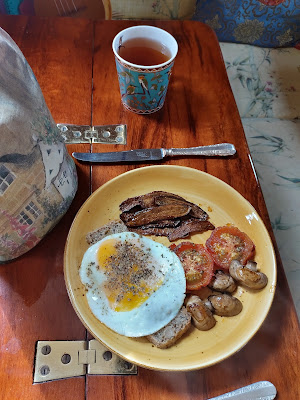For the voyager new to cooking, I include this recipe because scramblers are so lovely when well made and so liable to turn out disappointingly. To ensure success, don’t let yourself be distracted while cooking them; have the hot plates, toast, etc ready in advance and everyone sitting down in anticipation; use a little milk or water to help them stay moist; don’t use too high a heat.
The best tool for scrambling eggs is a flat, wooden spatula, if you have such a thing.
Serves 2
Ingredients
a large knob of butter – equivalent of a heaped tbsp, or olive oil
- Over a low heat, melt the butter and stir in a pinch of salt and the black pepper.
- Add the milk and eggs; beat quickly together for a moment until the yolks are broken and blended with the whites. You don’t want them to be totally incorporated as in an omelette.
- Cook gently, occasionally scraping the setting eggs from the bottom and sides of the pan – don’t stir too vigorously because you want to create soft, smooth curds.
- When all the egg is set, but before it starts drying out and turning rubbery, serve immediately, usually with hot toast, but it’s also good with freshly-baked bread.
Variations:
- A shake of chilli flakes, adds a 'lift' to the scramblers.
- A little minced garlic, or 1/8 tsp dried garlic granules, is delicious in scramblers at any time, and particularly if the eggs are getting past their best.
- Add a little grated cheese to the pan, as soon as you’ve put in the eggs.
- A few fresh herbs go well, especially parsley.
- Try some cracked black pepper, for a change.
- A couple of sliced mushrooms, fried in the butter/oil are delicious.
- Add a sliced tomato, or several sliced cherry tomatoes.
- If you add a little curry paste to the eggs, before beating them, the result makes a delicious snack on toast or crackers.
- If you are lucky enough to find wild garlic, this goes beautifully with scrambled egg.





